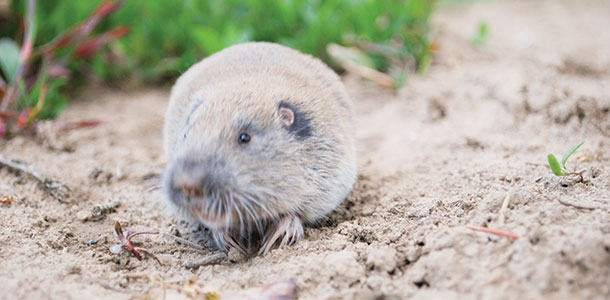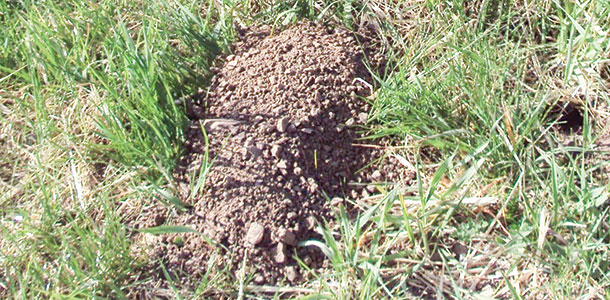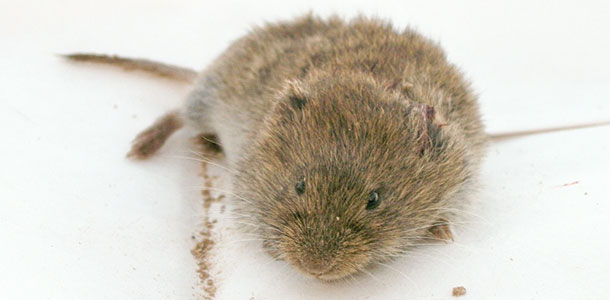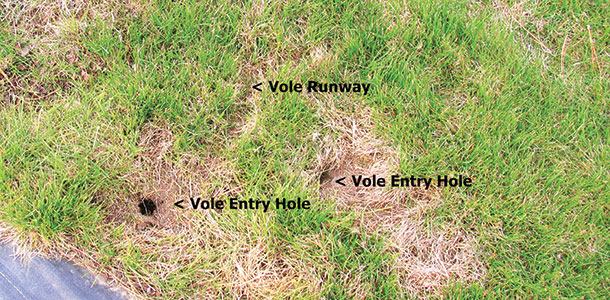Many ranchers and landowners are constantly attempting to eliminate or reduce these pesky problem animals. However, controlling burrowing rodents can be tough, especially if you do not know what you are dealing with.
I get a number of calls in my office asking for help controlling burrowing rodents. Usually before the phone call is over, I’ve changed my recommendation three times because the more information I gather from the landowner, the more I realize we are not talking about the same animal.
Identification is key to control
First and foremost – find out what you have. Control methods are different for each burrowing rodent. Ground squirrels, pocket gophers and voles (meadow mice) may occupy similar habitats and cause similar damage.
Before control measures can be successfully undertaken, one must identify the pest species, since control measures and materials are not the same.
- Ground squirrels are 8 to 10 inches tall, are active during the day and are often seen standing erect. Their activity is primarily aboveground. Ground squirrels have open burrows that are 4 to 5 inches in diameter.
- Pocket gophers are seldom seen and leave crescent- or horseshoe-shaped mounds with no apparent opening. Pocket gophers tend to stay underground in their extensive burrow systems and tunnels.
- Voles are much smaller than squirrels and gophers. Commonly called meadow mice, they have heavy bodies, short legs and tails, and look similar to a common mouse.
Voles create shallow tunnels and runways in vegetation that are normally 1 to 2 inches wide, with an entrance hole leading underground.
Ground squirrels
Ground squirrels are rodents from 8 to 10 inches long with tails 2 to 6 inches long. They come in a variety of colors, stripes and spots from gray to reddish-brown depending on their species.
They often stand erect, leading to the nickname of “picket pin.” When wary or startled, they may emit a squeak or whistle to warn other members of the colony.
In the Pacific Northwest there are 19 species of ground-dwelling squirrels belonging to five evolutionary groups. Those five groups include antelope ground squirrels, mantled ground squirrels, rock squirrels, true ground squirrels (small-eared group) and true ground squirrels (large-eared group).
In addition, a sixth ground-dwelling species, “marmots,” include the following species: yellow-bellied marmot (rock chuck), hoary marmot, Olympic marmot and wood chuck (groundhog).
In Idaho, six species are listed as “protected non-game species” by the Idaho Department of Fish and Game, including the northern Idaho ground squirrel, which is listed as a “threatened” species, and the southern Idaho ground squirrel, which is listed as a “candidate” species under the federal Endangered Species Act.
- Northern Idaho ground squirrel (Spermophilus brunneus brunneus)
- Southern Idaho ground squirrel (Spermophilus brunneus endemicus)
- Columbia Plateau (Merriam’s) ground squirrel (Spermophilus canus)
- Wyoming ground squirrel (Spermophilus elegans)
- Rock squirrel (Spermophilus variegates)
- Great Basin (Piute) ground squirrel (Spermophilus mollis)
These species are protected non-game species under Idaho law, and cannot be hunted or possessed.
Protected non-game status is not intended to prevent unintentional take of these species, protection of personal health or safety, limit property and building management, or prevent management of animals to address public health concerns or agricultural damage.
Preferred habitat for individual species of ground squirrels varies, but most varieties prefer meadow-grassland areas with light coverings of brush or trees. They avoid dense brush or forest situations.
However, most adapt readily to disturbed areas such as roadsides, ditch banks and levees. Most species will thrive alongside agricultural fields, feeding out into the field initially and eventually extending their burrow system.
Ground squirrels eat a wide variety of food but primarily consume a diet of green succulent vegetation (grasses, forbs and even brush) when available, switching to dry foods such as seeds later in the year.
The relatively high nutrient and oil content of the seeds aids in the deposition of fat necessary for hibernation. Most store large quantities of food in burrow caches.
Some species eat a greater amount of animal matter, including ground-nesting bird eggs. Insects and other animal tissue may make up to one-fourth of their diet.
Ground squirrels live in extensive, multi-entrance burrow systems that extend to more than 6 feet in depth. They have been known to appropriate and remodel the burrows and burrow systems of other rodent species.
Burrows are occupied and expanded continuously. They build nests in the burrow and return to the nest at night, during periods of high temperatures and when threatened by predators.
The squirrels generally enter their burrows to estivate, escaping the late-summer heat. They hibernate during the coldest part of the winter.
Males usually become active aboveground one to two weeks before the females in the spring, sometimes as early as late February or early March. The females become active and emerge one to two weeks later, when breeding takes place.
Gestation takes four to five weeks, and the litters of two to 10 are born in the burrow, where they are nursed for six to seven weeks. When one-third grown, pups begin to emerge to forage. One litter of pups is produced each year. Adults normally live four to five years.
Pocket gophers
 Pocket gophers are burrowing rodents that get their name from the fur-lined, external cheek pouches they use for carrying food and nesting materials.
Pocket gophers are burrowing rodents that get their name from the fur-lined, external cheek pouches they use for carrying food and nesting materials.
They are normally 5 to 14 inches long, range in color from black to brown, have small eyes and ears, flat heads with short necks and have large claws on their front paws.
There are three genera of pocket gophers in the U.S.: Thomomys, Geomys and Pappageomys, representing 18 different species. Genus classification is based on the size of the forefeet, claws and front surfaces of the incisors.
Identification of the species can be difficult, and generally only one species is defined per area.
Pocket gophers live in a burrow system that can cover an area of 200 to 2,000 square feet. The burrows are about 2.5 to 3.5 inches in diameter.
Gophers seal the openings to the burrow system with earthen plugs. Short, sloping lateral tunnels connect the main burrow system to the surface; gophers create these while pushing dirt to the surface to construct the main tunnel.
 Preferred habitat for pocket gophers is fine-textured, deep, porous soils conducive to digging and feeding, but they can also be found in varying geographic elevations, soils and conditions.
Preferred habitat for pocket gophers is fine-textured, deep, porous soils conducive to digging and feeding, but they can also be found in varying geographic elevations, soils and conditions.
Soils that do not hold tunnels, such as sandy soils, limit populations. Vegetation with large, fleshy roots or tubers creates ideal habitat for pocket gophers.
Annual crops, such as grains and annual grasses, are not ideal habitat for gophers because their shallow, fibrous root systems do not provide a good food source.
Gophers become sexually mature at 1 year old and can live for three to five years. Gophers breed in the spring and produce one or two litters per year, averaging four to six young per litter. In irrigated sites, gophers can produce up to three litters per year.
Birth occurs from March through June. Gophers don’t hibernate and are active year-round, although you might not see any fresh mounding. They also can be active at all hours of the day.
Gophers usually live alone within their burrow system except when females are caring for their young or during breeding season.
Voles
 Voles, also called meadow mice or field mice, belong to the genus Microtus. Several species of voles exist in the Pacific Northwest, and it can be difficult to distinguish between them. There are 23 vole species in the U.S.
Voles, also called meadow mice or field mice, belong to the genus Microtus. Several species of voles exist in the Pacific Northwest, and it can be difficult to distinguish between them. There are 23 vole species in the U.S.
The meadow vole, or meadow mouse (Microtus pennsylvanicus), is the most common species in pastures, rangelands, crops and lawns.
Meadow voles are compact rodents with stocky bodies, short legs and short tails. Their eyes are small and their ears partially hidden.
Their underfur is generally dense and covered with thicker, longer guard hairs. They usually are brown or gray, though many color variations exist. When fully grown, voles generally average 4.5 to 5.5 inches long, including the tail.
Voles occupy a wide variety of habitats, but they prefer areas with heavy ground cover of grasses, grasslike plants or litter.
 Vegetation greater than 6 inches in height, snow cover, brush piles and leaves provide protection from predators. Rangeland, alfalfa and grass hayfields, pasture, orchards and home lawns and gardens provide ideal habitat and food sources for these pests.
Vegetation greater than 6 inches in height, snow cover, brush piles and leaves provide protection from predators. Rangeland, alfalfa and grass hayfields, pasture, orchards and home lawns and gardens provide ideal habitat and food sources for these pests.
Voles prefer cover when feeding and do not like crossing bare ground. Feeding activity can be easily recognized by the presence of shallow tunnels and runways in vegetation. Runways are approximately 1 to 2 inches wide, with an entrance hole leading underground.
Voles are active day and night, year-round. However, most activity occurs at night during the spring and fall. They do not hibernate. Voles may breed throughout the year but most commonly in spring and summer. They average one to five litters per year with three to six young per litter.
Gestation length is approximately 21 days. Young are weaned by the time they are 21 days old, and females mature in 35 to 40 days. Life spans are short, probably ranging from two to 16 months.
Large population fluctuations are characteristic of voles. If habitat is abundant and provides adequate protection from predators, weather conditions are ideal and abundant food sources exist, vole populations can quickly reach damaging levels.
Management
Remember, identification is key to control and management of burrowing animals. Once you have properly identified the problem animal, contact your local county extension office for recommendations of control methods. ![]()
References omitted due to space but are available upon request. Click here to email an editor.
PHOTOS
PHOTO 1: Ground Squirrel burrow
PHOTO 2: Pocket gopher - Photo courtesy of Glen Shewmaker, UI Extension
PHOTO 3: Pocket Gopher mound - Photo courtesy of Sarah D. Baker, UI Extension
PHOTO 4: Vole - Photo courtesy of Danielle Gunn, UI Extension
PHOTO 5: Vole Runway/holes - Photo courtesy of Danielle Gunn, UI Extension

-
Sarah D. Baker
- Extension Educator
- University of Idaho Extension
- Email Sarah D. Baker








